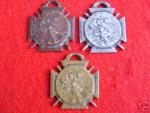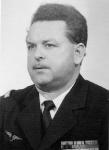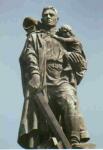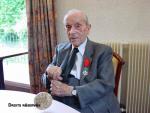-
Posts
3,939 -
Joined
-
Last visited
-
Days Won
1
Content Type
Profiles
Forums
Blogs
Gallery
Events
Store
Everything posted by Christophe
-
I have already seen this one. It exists in different grades (see pic attached). I have no precise detail about it. Ch.
-
Hi Jef, They are usually named. The one Darrell and you are showing are of the 4th type. I have one of the 3rd type named in 1908. Ch.
-
Hi Jef, This one is the UNC medal for the 60 Years of WW1. I have, frankly, not anymore additional detail about it... It is in bronze, with a 32mm module, and has been instituted in 1978. Ch.
-
Kev, Don't know about this one... Seems to be a recent strike... Ch.
-
Difficult to say.... Let's the expert talk.... The UNC managers decided to distroy the archives of the UNC during WW2 for security reasons (linked to Members). I would say beginning of the 1920s for the 1st type- mid 1920s - 1930s for the 2nd type. But... Ch.
-

Soviet Soviet & Eastern Block Quiz
Christophe replied to Christophe's topic in Russia: Soviet: Other Militaria
Bravo Bryan!!! You're the winner!!! Effectively Dubcek himself later recalled after the 21 March match : "The whole country watched (on TV) as Czechoslovakia played the Sovites; it was much more than ice hockey, of course. It was replay of a lost war..." (Dubcek, Hope Dies Last). The Czechs won. According to the Mitrokhin Archive (p. 262), The KGB (with local support of the Czech Ministry of Interior)) prepared an anti Soviet riot to follow the next match on 28 March. Shortly before the match, a team of police agents unloaded a pile of working stones in front of the offices of the Aeroflot, in Wenceslas Square. And, immediately after the match, the celebrating crowd (helped by the StB) began to throw the conveniently placed stones at the Aeroflot office. Dubcek had no option but to resign, as Moscow had the fabricated evidence it required to demand that "the counter-revolution must be beheaded". Dubcek was succeded by Husak on 17 April. Bravo again Bryan!!!! Your turn now!!! Ch. -
Hi Jef, Thanks for posting it. This is the 1st type, with Chobillon (not Ghobillon) on the reverse. Ch.
-
I don't have it, but will try to find a pic. Ch.
-

France Essential Site for French Orders and Medals
Christophe replied to Michael Johnson's topic in France
Never too late to try... Ch. -

France Essential Site for French Orders and Medals
Christophe replied to Michael Johnson's topic in France
I would say a VERY nice one!!!! Why Babelfish ? Ch. -

France Essential Site for French Orders and Medals
Christophe replied to Michael Johnson's topic in France
I agree. This site, by Marc Champenois, is obviously the best site in french about French medals and orders. A lot of historical and regulatory details and informations. Very good pics as well!!!!! Ch. -

Soviet Soviet & Eastern Block Quiz
Christophe replied to Christophe's topic in Russia: Soviet: Other Militaria
Ok, my turn... Something a litle bit different... In March 1969, The World Ice Hockey Championship took place in Stockholm (Sweden). The USSR finally won the competition. On 21 and 28 March, two very sensitive matches took place, opposing the two same countries. These matches each time, led to public demonstrations. The last one, on 28 March, had a few weeks later important political consequences at a country level. Here are my questions : 1. Which were the 2 countries involved in these matches, and who won (the same country won the 2 matches) ? 2. What precisely happened after the 28 March match ? How ? And where ? 3. What has been the immediate political consequence of these matches and the associated events ? Which political decision has been taken ? The first Member who can provide the complete 3 answers is.... the winner!!!!!! Good hunt!! Cheers. Ch. -

Only 75 Companions of the Liberation still alive!
Christophe replied to Christophe's topic in World War II 1939 to 1945
Only 73 surviving Companions of the Liberation We have learnt this week the death of Marius Guyot, Companion of the Lib?ration, on 25 September 2006. Marius Guyot, born in 1918, has fought on Koufra, Fezzan, Italy, Provence and Germany battlefields. Here is his bio (in French) : http://www.ordredelaliberation.fr/fr_compagnon/447.html After his death, there are now only 73 surviving Companions of the Liberation. Ch. Pic : Chancellerie de l'Ordre de la Lib?ration. -
Hi Darrell, May I precise this nice medal is not THE official Commorative Medal for WW1, but the one issued by the UNC (Union Nationale des Combattants), a French WW1 veterans association. This is type 2 of this medal. Nice one. Ch.
-

Only 6 "Poilus" still alive !
Christophe replied to Christophe's topic in The Great War 1914 to 1918
You're correct. Here you can find the link : http://gmic.co.uk/index.php?showtopic=11572 Ch. -
Chris, M?daille du Travail. It is not specifically for working for the Gvt, even if it may be so. This medal is awarded to salaries (or assimilated) for long service, minimum 20 years in the normal case, and normally in no more than 4 companies. Can be reduced to 18 years in case of penibility fo the job... You have to ask for it, and your employer decides or not to make the demand to the Ministry. Generally it does it, as a reconnaissance of the employee's merits. The statutes of this medal have a lot evolved along the years; the 1st type being created in 1866. The face (obverse) has not evolved a lot, as it is still the work of Maurice Borrel since the beginning. There are several different types of reverses. I have been told more than 80 different versions... This medal is quite popular in france, as its awarding by the emplyer is generally associated with a financial bonus. So employees generally ask for it... Ch.
-

Soviet Soviet & Eastern Block Quiz
Christophe replied to Christophe's topic in Russia: Soviet: Other Militaria
Simon, Very interesting precision. A nice story. Ch. -

Soviet Soviet & Eastern Block Quiz
Christophe replied to Christophe's topic in Russia: Soviet: Other Militaria
Ha, ha !!!!! Ch. -

Soviet Soviet & Eastern Block Quiz
Christophe replied to Christophe's topic in Russia: Soviet: Other Militaria
Thanks Simon. An interesting one. I'm afraid that, again, it's my turn.... Ch. -

Soviet Soviet & Eastern Block Quiz
Christophe replied to Christophe's topic in Russia: Soviet: Other Militaria
-

Soviet Soviet & Eastern Block Quiz
Christophe replied to Christophe's topic in Russia: Soviet: Other Militaria
Hi Simon, You are here talking to a real Berlin lover !!! Our man is Nikolay Masalov, a Soviet soldier who saved a German girl. His action inspired the sculptor of the monument... certainly as a propaganda objective... Am I right ? Cheers. Ch. -

Only 6 "Poilus" still alive !
Christophe replied to Christophe's topic in The Great War 1914 to 1918
Hi Dan, I have to say that a real good job has been done by the French Ministry of Defense these last years. Not only have they published the booklet mentioned earlier, but they have also scanned all available combattant cards of french WW1 vets. This gives as a result an extremely well done, extensive and easy to consult database, as it is available on the web. Last but not least, all Poilus have been honoured these last years : presence in official commemoration ceremonies, awards of the L?gion d'Honneur, attention of the media and stories published... Cheers. Ch. -

Soviet Soviet & Eastern Block Quiz
Christophe replied to Christophe's topic in Russia: Soviet: Other Militaria
Excellent Simon!! We have a winner!!!! Our "mystery" Heroin is Zinaida Martynovna Portnova, commonly known as Zina Portnova. Born on 20 February 1926, she died in January 1944. She was a Russian teenager, Soviet partisan and Hero of the Soviet Union. Zina Portnova was born in Leningrad and was a seventh grade student spending summer in a children's camp in Vitebsk region when Nazi Germany invaded the Soviet Union. In 1942 Portnova joined the Belarusian resistance movement, becoming a member of the local underground Komsomol organization in Obol, Vitebsk Voblast, named Young Avengers. Young partisan was distributing Soviet propaganda leaflets in the German occupied Belarus and participated in a number of sabotage actions. In August of 1943 she became a scout of the partisan unit named after Kliment Voroshilov. In October 1943 Portnova joined VLKSM. Two months later she was captured by the Germans, tortured, blinded and then shotl. In July 1958, Zina Portnova was posthumously made a Hero of the Soviet Union. There is a complete bio of her in Henry Sakaida's "Heroines of the Soviet Union" (Osprey) where the pic I posted is coming from. Simon, Congrats. Your turn now . Cheers. Ch. -

Only 6 "Poilus" still alive !
Christophe replied to Christophe's topic in The Great War 1914 to 1918
Only 5 "Poilus" still alive ! This week a WWI veteran died in France, aged 105. "Fran?ois Jaffr? one of France's last surviving veterans of the First World War, has died at the age of 105, the National Veterans' Office said. Jaffre died on Friday in a retirement home outside Paris. His death leaves France with just five officially-recognised surviving veterans of the Great War. The oldest, Maurice Floquet, turns 112 on December 25. Jaffre was nearly excluded from the revered club of living veterans of the First World War. He had slipped off the list of survivors in 1997 after failing to tell officials he had moved from his Paris home to a retirement home in the suburban Yvelines region. Jaffre was reregistered in March after French newspapers brought his case to light. Born May 28, 1901, Jaffre lost his mother when he was 14. He chose to leave school to enrol in navy college and signed a 10-year military contract in September 1917, aged 16. Jaffre served as a radio operator on a submarine escort protecting American troops and equipment on their journeys from New York to France. During the Second World War, Jaffre, with his experience of deciphering codes, worked in counter-intelligence for France's external intelligence agency. In 1996, he was awarded France's highest award, the Legion of Honour." Ch. Pic : AFP






